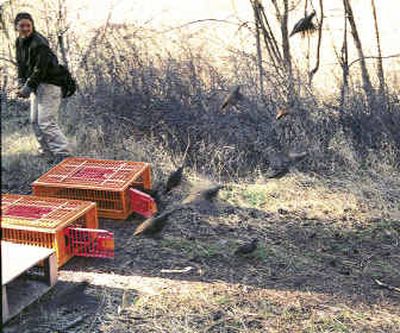Reintroduction effort gives mountain quail a new start

LEWISTON – Like miniature rockets, about 70 mountain quail burst from manmade plastic crates into wild new habitat one Saturday in March.
Each bird produced a thunderous, sputtering sound as its swiftly beating wings propelled it into nearby trees and shrubs.
Chatter from the birds quickly began bouncing around the narrow canyon as they called to each other while exploring the thick brush, tall ponderosa pine trees and rocky basalt outcroppings of Asotin Creek.
“This is an exciting thing to see happen,” said Mike Denny, a bird and small animal biologist for Umatilla National Forest at Walla Walla. “This is prime habitat.”
Denny marveled at the calls but also wished they would subside before any goshawks, Cooper’s hawks or sharp-shinned hawks were alerted to the arrival of the birds they like to eat.
“Now you cross your fingers and hope an accipiter doesn’t find them.”
Denny explained accipiters are birds that feed on other birds. Staying clear of the sharp talons of the fast-flying and acrobatic hawks will be one of the toughest challenges for the quail.
Deep in Corral Creek, across the Snake River on Idaho’s Craig Mountain, other mountain quail burst into the wild Saturday and are now busy checking out their new environment.
The Washington Department of Fish and Wildlife and the Idaho Department of Fish and Game each released a few more than 70 mountain quail into areas that once supported thriving populations of the locally rare game birds. The released birds were captured from healthy populations in western Oregon.
Both agencies are trying to re-establish mountain quail here and say hunting could one day be allowed if all goes well.
With long, straight plumes similar to slanted exclamation points, mountain quail have a distinct appearance from common California quail with their backward, question mark-like plumes. They also have a call that is distinct from their California cousins. But when the birds flush, they appear nearly identical.
Because of that, both departments say bird hunters should take care to identify their targets before shooting next fall.
California quail are open to hunting but the season on mountain quail has been closed for more than 20 years in both states.
Mountain quail are native birds that have been declining in numbers the past 40 years, according to Ashley Martens, a University of Idaho graduate student heading the reintroduction effort. Nobody knows exactly why the birds have declined so dramatically in Idaho and Eastern Washington but habitat degradation from grazing, dam building and fire suppression, accompanied by predation and hunting, are possible culprits.
“We know as far as distribution, their range has declined 90 percent,” said Martens.
Pat Fowler, district wildlife biologist for the Washington Department of Fish and Wildlife at Walla Walla, has seen just three mountain quail in 31 years of tromping around the state’s wild areas.
“Some of the old-timers you talk to, they talk about mountain quail being quite abundant throughout the Blue Mountains,” he said.
In Idaho, Craig Mountain wildlife manager Jim White said the agency receives reports of one or two mountain quail being seen there once or twice a year.
Both state agencies plan to release more birds next year to augment the reintroduction effort. Over the course of the next two years, the birds will be diligently followed and studied by Martens. She will observe where the birds move and what kind of habitat they seem to prefer. When birds die, Martens will attempt to learn the cause.
About 50 of the quail were outfitted with tiny radio collars to make tracking easier. The information she collects will help with future releases of the birds.
Mountain quail typically don’t move from drainage to drainage and instead tend to migrate up and down in elevation while staying within a small geographic range.
However, some of the released quail have been drainage hopping as they explore their new surroundings. Martens guesses they will look for forested areas similar to the habitat they came from in Oregon.
It would likely be years before mountain quail recover to huntable numbers, but that is the long-term goal. For now, people will have to be content with just the opportunity to hear and see the birds.